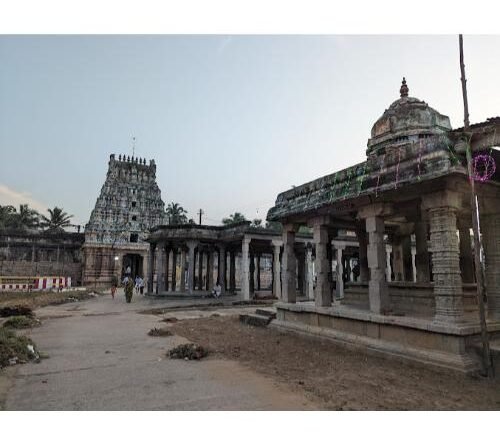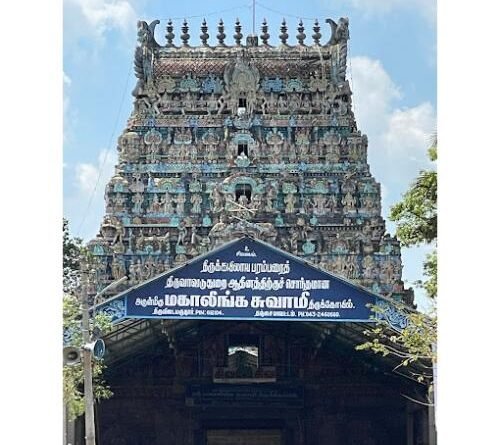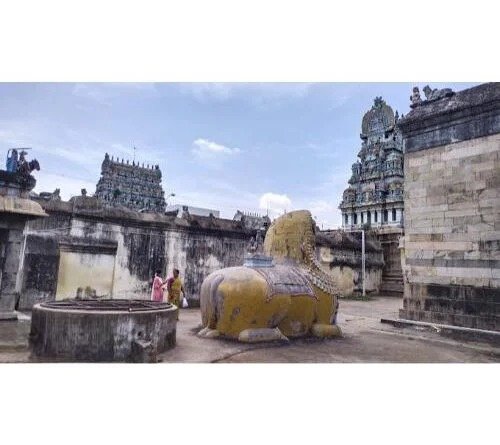Sri Mahalingaswami Kovil/Mahalingeswaraswamy Temple Thiruvidaimarudur,Tamil Nadu
Mahalingeswaraswamy Temple, Thiruvidaimarudur is a Hindu temple dedicated to the deity Shiva, located in Tiruvidaimaruthur, a village in the South Indian state of Tamil Nadu. It is significant to the Hindu sect of Saivism as one of the seven major Shiva temples. Shiva is worshiped as Mahalingeswaraswamy, and is represented by the lingam, with his idol referred to as Jyothirmayalingam. His consort Mookambika is depicted as Devi Bruhatsundarakuchaambika or Bruhatsundarakuchaambigai amman. The lingam of the temple is believed to be the focal point for the seven consorts of Shiva. The presiding deity is revered in the 7th-century-CE Tamil Saiva canonical work, the Tevaram, written by Tamil poet saints known as the nayanars and classified as Paadal Petra Sthalam.
The 9th-century-CE Saiva saint poet Manikkavacakar has sung praise about the temple in his works. Pattinattar, one of the revered saints visited this shrine many times .
There are 149 inscriptions associated with the temple indicating contributions from Pandyas, Cholas, Thanjavur Nayaks and Thanjavur Maratha kingdom. The oldest parts of the present masonry structure were built during the Chola dynasty in the 9th century, while later expansions, including the towering gopuram gatehouses, are attributed to later periods, up to the Thanjavur Nayaks during the 16th century.
The temple complex is one of the largest in the state and it houses four gateway towers known as gopurams. The temple has numerous shrines, with those of Mahalingeswaraswamy, Bruhatsundarakuchaambika and Mookambigai ( or Devi Mookambika ) being the most prominent. The temple complex houses many halls and three precincts; the most notable is the second precinct built during the Vijayanagar period that has many sculptures. The temple has six daily rituals at various times from 5:30 a.m. to 10 p.m., and twelve yearly festivals on its calendar. The temple is maintained and administered by Thiruvaduthurai Adheenam, a South Indian monastic institution.
Legend
Tiruvidaimaruthur temple
The name “Kumbakonam”, roughly translated in English as the “Jug’s Corner”,is believed to be an allusion to the mythical pot (kumbha) of the Hindu god Brahma that contained the seed of all living beings on earth. The kumbha is believed to have been displaced by a pralaya (dissolution of the universe) and ultimately came to rest at the spot where the town of Kumbakonam now stands. The drops of nectar are believed to have fallen onto five shrines around Kumbakonam, namely Mahalingeswarar temple at Tiruvidaimarudur, Tirudharasuram, Naganathar Temple at Tirunageswaram, Tiruvorgam and Tirupadalavanam.
The legend of a Chola prince who killed a Brahmin and was in turn, pursued by his spirit (Brahmarakshas), is associated with the temple. The Chola prince, it is believed, entered the Mahalingeswarar Temple and prayed to his favourite God, Shiva for relief from the clutches of the spirit of the dead Brahmin or brahmarakshas. The Chola prince made his way out through another entrance thereby saving himself.[6] Some sources associate the legend with Pandya king Varagunapandian. It continues till day where people take the second entrance to exit the premises after worship. There is a sculpture of Chola brahmaharakshas on the eastern premises in one of the inner gopurams (tower gateway).
Shiva is believed to have appeared as a flame to please Agastya and other sages who were performing penance. Shiva (Rudra) is said to have emanated from the heart of Mookambika. It is also believed that several other deities like Vinayaga, Murugan, Parvathi, Kali, Lakshmi, Saraswathi, Brahma, Airavata (the elephant of celestial king Indra) and Vishnu worshipped Mahalingaswamy.
















